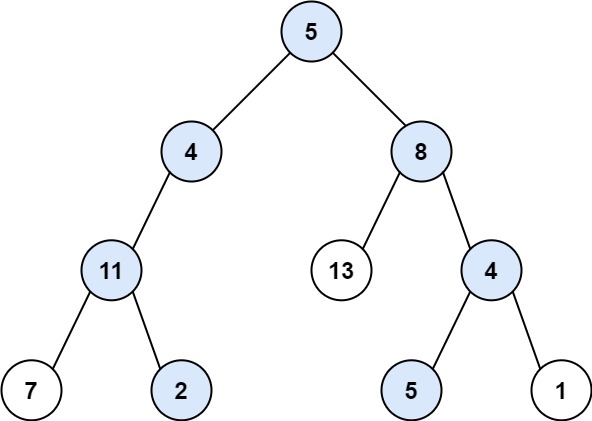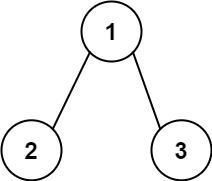113. Path Sum II
Path Sum II
Given the root of a binary tree and an integer, return all root-to-leaf paths where the sum of the node values in the path equals targetSum. Each path should be returned as a list of the node values, not node references.
A root-to-leaf path is a path starting from the root and ending at any leaf node. A leaf is a node with no children.
Example 1:

Input: root = [5,4,8,11,null,13,4,7,2,null,null,5,1], targetSum = 22
Output: [[5,4,11,2],[5,8,4,5]]
Explanation: There are two paths whose sum equals targetSum:
5 + 4 + 11 + 2 = 22
5 + 8 + 4 + 5 = 22
Example 2:

Input: root = [1,2,3], targetSum = 5
Output: []
Example 3:
Input: root = [1,2], targetSum = 0
Output: []
Constraints:
- The number of nodes in the tree is in the range
[0, 5000]. -1000 <= Node.val <= 1000-1000 <= targetSum <= 1000
/**
* @param {TreeNode} root
* @param {number} sum
* @return {number[][]}
*/
var pathSum = function(root, sum) {
if (root === null) return [];
const res = [];
backtrack(root, sum, res, []);
return res;
};
function backtrack(root, sum, res, tempList) {
if (root === null) return;
if (root.left === null && root.right === null && sum === root.val)
return res.push([...tempList, root.val]);
tempList.push(root.val);
backtrack(root.left, sum - root.val, res, tempList);
backtrack(root.right, sum - root.val, res, tempList);
tempList.pop();
}
/**
* Definition for a binary tree node.
* function TreeNode(val) {
* this.val = val;
* this.left = this.right = null;
* }
*/
/**
* @param {TreeNode} root
* @param {number} sum
* @return {number[][]}
*/
var pathSum = function(root, sum) {
var result = [];
if (!root) {
return result;
}
genPath(result, root, [], 0, sum);
return result;
};
function genPath(result, root, curArr, curSum, target) {
curArr.push(root.val);
curSum += root.val;
if ((curSum === target) && !root.left && !root.right) {
result.push(curArr);
return;
}
if (root.left) {
genPath(result, root.left, curArr.concat(), curSum, target);
}
if (root.right) {
genPath(result, root.right, curArr.concat(), curSum, target);
}
}That’s all folks! In this post, we solved LeetCode problem #113. Path Sum II
I hope you have enjoyed this post. Feel free to share your thoughts on this.
You can find the complete source code on my GitHub repository. If you like what you learn. feel free to fork 🔪 and star ⭐ it.
In this blog, I have tried to solve leetcode questions & present the most important points to consider when improving Data structure and logic, feel free to add, edit, comment, or ask. For more information please reach me here
Happy coding!

Comments
Post a Comment